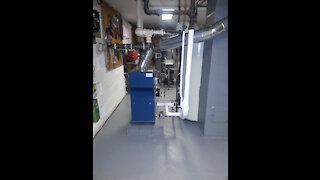Premium Only Content

Lumbar Fusion Patient: 4 Discs Replaced
This particular patient injured her back. Since her injury, she was not able to walk which led her to meet Synapse Orthopedic Group's Edwin Haronian MD. She later received surgery on her back and since her surgery, she can now walk again and is recovering on a day to day basis.
Call us to schedule an appointment: (818) 788-2400
Locations in Pomona, Sherman Oaks, and Los Angeles
Spinal fusion is a surgical procedure used to correct problems with the small bones of the spine (vertebrae). It is essentially a "welding" process. The basic idea is to fuse together the painful vertebrae so that they heal into a single, solid bone.
Spine surgery is usually recommended only when your doctor can pinpoint the source of your pain. To do this, your doctor may use imaging tests, such as x-rays, computed tomography (CT), and magnetic resonance imaging (MRI) scans.
Spinal fusion may relieve symptoms of many back conditions, including:
Degenerative disk disease
Spondylolisthesis
Spinal stenosis
Scoliosis
Fracture
Infection
Tumor
Understanding how your spine works will help you better understand spinal fusion.
Spinal fusion eliminates motion between vertebrae. It also prevents the stretching of nerves and surrounding ligaments and muscles. It is an option when motion is the source of pain, such as movement that occurs in a part of the spine that is arthritic. The theory is if the painful vertebrae do not move, they should not hurt.
If you have leg pain in addition to back pain, your surgeon may also perform a decompression (laminectomy). This procedure involves removing bone and diseased tissues that can put pressure on spinal nerves.
Fusion will take away some spinal flexibility, but most spinal fusions involve only small segments of the spine and do not limit motion very much.
Lumbar spinal fusion has been performed for decades. There are several different techniques that may be used to fuse the spine. There are also different "approaches" your surgeon can take for your procedure.
Your surgeon may approach your spine from the front. This is an anterior approach and requires an incision in the lower abdomen.
A posterior approach is done from your back. Or your surgeon may approach your spine from the side, called a lateral approach.
Minimally invasive techniques have also been developed. These allow fusions to be performed with smaller incisions.
The right procedure for you will depend on the nature and location of your disease.
Bone Grafting
All spinal fusions use some type of bone material, called a bone graft, to help promote the fusion. Generally, small pieces of bone are placed into the space between the vertebrae to be fused.
A bone graft is primarily used to stimulate bone healing. It increases bone production and helps the vertebrae heal together into a solid bone. Sometimes larger, solid pieces are used to provide immediate structural support to the vertebrae.
In the past, a bone graft harvested from the patient's hip was the only option for fusing the vertebrae. This type of graft is called an autograft. Harvesting a bone graft requires an additional incision during the operation. It lengthens surgery and can cause increased pain after the operation.
One alternative to harvesting a bone graft is an allograft, which is cadaver bone. An allograft is typically acquired through a bone bank.
Today, several artificial bone graft materials have also been developed.
Demineralized bone matrices (DBMs). Calcium is removed from cadaver bone to create DBMs. Without the mineral, the bone can be changed into a putty or gel-like consistency. DBMs are usually combined with other grafts, and may contain proteins that help in bone healing.
Bone morphogenetic proteins (BMPs). These very powerful synthetic bone-forming proteins promote a solid fusion. They are approved by the U.S. Food and Drug Administration for use in the spine in certain situations. Autografts may not be needed when BMPs are used.
Ceramics. Synthetic calcium/phosphate materials are similar in shape and consistency to autograft bone.
Your surgeon will discuss with you the type of bone graft material that will work best for your condition and procedure.
Immobilization
After bone grafting, the vertebrae need to be held together to help the fusion progress. Your surgeon may suggest that you wear a brace.
In many cases, surgeons will use plates, screws, and rods to help hold the spine still. This is called internal fixation, and may increase the rate of successful healing. With the added stability from internal fixation, most patients are able to move earlier after surgery.
For more information please visit our website at: http://www.synapsedoctor.com
You can also follow our social media pages at:
http://www.facebook.com/synapsedoctor
http://www.instagram.com/synapsedoctor
http://www.twitter.com/synapsedoctor
-
 1:05
1:05
KenWilliams1
3 years agoExtremely Patient Dog
301 -
 1:54
1:54
Sparkle Dance Academy
4 years ago $0.02 earnedSpanish Fusion Class
209 -
 0:33
0:33
Tank24
4 years agoPatient pitbull with baby
124 -
 3:55
3:55
Just an FYI
4 years ago $0.01 earnedReplaced steam boiler
549 -
 2:11
2:11
WFTX
3 years agoPediatric cancer patient inspries others
15 -
 0:23
0:23
Claritathedog
3 years agoPatient dog nurses adorable kitten
95 -
 5:07
5:07
Bellydancer Damkina
3 years agoDamkina perform a modern fusion with shamadan
82 -
 17:55
17:55
Verdier400
3 years ago2019-2020 Ford Fusion Energi: Ride Around
18 -
 1:09:59
1:09:59
Geeks + Gamers
4 hours agoSonic 3 DESTROYS Mufasa And Disney, Naughty Dog Actress SLAMS Gamers Over Intergalactic
32.7K8 -
 51:59
51:59
The Dan Bongino Show
5 hours agoDemocrat Donor Admits The Scary Truth (Ep. 2393) - 12/23/2024
569K1.55K